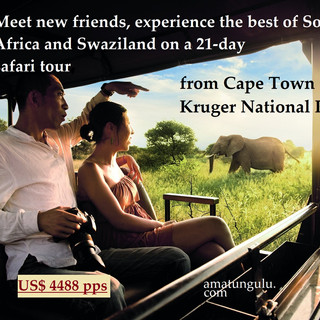What to Pack for Safari and Tours.
- Jakes Conrdie
- Aug 16, 2018
- 3 min read
If this is your first time on safari, packing can be a daunting task. The less you pack, the more convenient it will be to move around and the happier you’ll be. ‘Less is more’ is a good principle for touring and safari. The best time to visit South Africa for safari is after the worst summer heat is over, between March and October. During this period, there is less vegetation and animals are more concentrated around rivers and waterholes, making it easier to spot them. There are also fewer mosquitos. Depending on your destination, summer months are recommended for the coastal and high lying areas like Cape Town and the Drakensberg. However, it can get cold in the evenings during this time of the year. That means you’ll need to bring a jacket or two for game drives at sunrise and sunset. In general, winter is very mild in South Africa and Swaziland. Temperatures in the lowlands range from 12 to 25 degrees Celsius, and in the mountains from 3 to 10 degrees Celsius. Most of East Africa are high-risk malaria areas, so be sure to get malaria medication at home before your trip. The best is to consult your doctor. You’ll need to start taking it a few days before your trip and continue for a few weeks after the trip. It’s not advisable for kids under five to take malaria medication. Book at www.amatungulu.com.
Clothing: There’s a reason why everyone wears earth tone clothing on safari. They help you to blend in to the natural environment. Wearing neon pink leggings or a bright yellow shirt might scare off the animals, especially if you’re on a walking safari. It’s also good to look for clothing made of breathable, lightweight material, as it can get pretty hot even during winter in Africa.
Long Pants: Regardless of which time of the year you’re traveling, you’ll need to pack long pants as they’ll protect your skin from mosquito bites and sun exposure. I recommend bringing zip-off pants i.e. pants that can be converted into shorts when the weather gets too warm. It can be uncomfortable wearing long sleeves in hot weather, but they are useful to prevent scrapes and bites. I recommend opting for light and breathable long-sleeved shirts that are designed for trekking.
Waterproof Jacket: Again, no matter when you’re traveling, you’ll need a light waterproof jacket for chilly mornings/evenings or rain. We were traveling in winter time, so a good waterproof jacket definitely was essential. Keep in mind that most safari jeeps are completely open-roofed (i.e. no windows or cover), so it can get really chilly during morning and evening game drives. Plus you’ll be guaranteed to get wet when it rains, so make sure your jacket is waterproof.
Cash: You won’t find credit card machines in the African bush, so make sure you get enough cash in the city before you head into the savanna. While some lodges accept credit cards, you’ll likely need some cash when visiting villages or buying souvenirs. You’ll also need cash to tip your guides and porters.
Here is a list that should be helpful, depending on the season and time:
Safari Clothes for Adults
One light jacket
One fleece
Three pairs safari pants (one of them zip-off)
One pair shorts
One long-sleeve shirts (light, breathable)
Four short-sleeve shirts
One dress (for nice dinners)
A set of pyjamas
A pair of hiking boots
A pair of sandals (or Keens)
Underwear
Sports bra (for women)
Three pairs of socks
Sun hat
Swimsuit
Sunglasses
Safari Clothes for Kids
One down jacket (for cold winter nights)
One light jacket
Two fleece
Three pairs zip-off safari pants
One pair shorts
Four short-sleeve shirts (quick dry)
Two sets of pyjamas
A pair of hiking boots (or walking shoes)
A pair of sandals
Underwear
Three pairs of socks
Sun hat
Swimsuit
Sunglasses
First-Aid Kit:
Pain tablets for both adults and kids
Anti-histamine for allergic reactions
Anti-diarrhoea pills
Anti-malaria pills (if you’re traveling in malaria risk areas)
Cough drops
Band-Aid
Electronics:
Camera
Lenses
Portable power bank (to charge devices in lodges without electricity)
International plug converter
Chargers and charging cables
iPad, Kindle or books for long car rides
Headphones
Other Essentials:
Standard toiletries
Toothbrush/toothpaste
Sunscreen
Snacks for kids (yogurt and puree pouches)
Wet wipes
Head torch or flashlight
Binoculars
Visas
Passports
Cash
Insect repellent: This is essential especially if you’re traveling in high-risk malaria areas. It’s always better to prevent bites, even if you’re taking anti-malaria pills.
You will receive some repellent cream in your gift pack with compliments from Amatungulu Tours, but it is still advisable to take your favorite brand.
Hurry, tours are selling out! Book at www.amatungulu.com.




Nice bblog you have